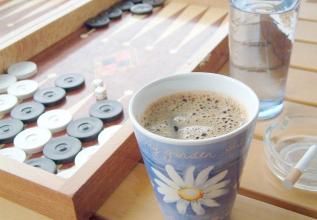Introduction to the coffee flavor and taste characteristics of Nicaraguan Tianyi Manor with excellent sense of balance
Since July 1927, Augusto. Cesar. Sandino led the people in a guerrilla war against the US occupation, forcing the US military to withdraw in 1933. On February 21, 1934, the Commander of the Nicaraguan National Guard, Anastacio. Somocha. Garcia assassinated Sandino at the behest of US President Roosevelt. He became president in 1936 and established a pro-American "Cordillo" dictatorship for more than 40 years until 1979. In 1964, the Sandinista National Liberation Front (SPLF) was established to carry out a revolutionary struggle against the Somocha dictatorship. Managua, the capital of Nicaragua, is located in the west of the border, located on the south bank of Lake Managua, hence its name. The northwest is 140 kilometers away from the Collinto seaport on the Pacific coast. 55 meters above sea level. It is a Spanish city with beautiful scenery. Because it is located on the east side of the Pacific volcanic active seismic belt, there have been four strong earthquakes in the city in the past 100 years, one of which caused the worst damage to the city in December 1972. The rebuilt Managua has taken many important measures in reducing population density, moving large enterprises to other places and improving the earthquake-proof capacity of buildings. The word Managua comes from the Indian Naval language, and its meaning has two interpretations, one is "Mexican place", and the other is "waterside". About 10,000 years ago, there were human activities on the shores of Lake Managua, and the remains of ancient human activities can be seen from the Acorink site. As a result of natural disasters such as earthquakes, residents have moved many times. When the Spaniards conquered Nicaragua in the early 16th century, it was still an important Indian village. It became a city in 1846. It was designated as the capital of the Republic in 1852. It has since become the political center of the country, the Republic of Nicaragua (English: The Republic of Nicaragua; Spanish: La Rep ú blica de Nicaragua). The interpretation of the name of the country comes from the surname of the Indian chief Niagaru, also known as "the land of lakes and volcanoes". [4]
National flag
Nicaraguan flag
Nicaraguan flag
The Nicaraguan national flag was launched on August 27th, 1971. the national flag is rectangular and the ratio of length to width is 5:3. The flag is made up of three parallel rectangles from top to bottom. The national emblem is painted in the central government. The color of the national flag comes from the original Central American federal flag and symbolizes the country's geographical location between the Pacific Ocean and the Caribbean Sea.
When tasting Nicaraguan coffee, it is best to drink cold water first, so that you can better feel its mellow taste. Drink coffee while it is hot, because the tannins in Nicaraguan coffee are easy to change during cooling, and the taste becomes sour, which will affect the flavor of the coffee. You can add the right amount of sugar, and then add cream. Enjoy a cup of high-quality Nicaraguan coffee, you can not only experience the different levels of coffee taste, but also help to improve the ability to appreciate coffee.
Coffee is Nicaragua's main export. According to the president of the Nicaraguan Coffee Farmers' Federation, due to the poor harvest of coffee in Nicaragua's Pacific region, the country's total coffee production in 1998 may be 12% lower than that in 1997. In the 1997-1998 coffee year, Nicaragua harvested a total of 1.422 million bags (46kg per bag) of coffee, the best harvest in 14 years after coffee production hovered around 1 million bags. It is estimated that the income from coffee exports in 1998 will be about 1.6 billion US dollars, and Nicaraguan coffee production will drop sharply. Wei Kailei coffee is Nicaragua's main export product. According to the president of the Nicaraguan Coffee Farmers' Federation, due to the poor harvest of coffee in the Nicaraguan Pacific region, the country's total coffee production in 1998 may be 12% lower than that in 1997 and 1998 because of the national character of the Latin American people. it makes it difficult for foreign buyers to do business directly with the Latin people, the Latin people do not attach importance to credit, things are too casual, and the quality of the shipment is not accurate. Export products are also mixed with sundries, but in fact, Latin America does have a good growing environment suitable for growing agricultural products around the world, so we came to Nicaragua to ensure the quality of goods and shipments on schedule. I hope to enable coffee lovers to enjoy high-quality Nepalese coffee, the cultivation and production of Nepalese coffee has a unique environment, fertile volcanic soil and shade. Having established a good production quality, Nepalese coffee has rich mellow and fragrant taste, moderate acidity and excellent balance of bitter taste, which is regarded as top grade in the eyes of international coffee experts.

Important Notice :
前街咖啡 FrontStreet Coffee has moved to new addredd:
FrontStreet Coffee Address: 315,Donghua East Road,GuangZhou
Tel:020 38364473
- Prev

Introduction to the flavor and taste characteristics of fragrant, pure and slightly sour El Mercedes Manor coffee
The ancient city was built on a peninsula extending into the Atlantic Ocean and occupies the end of a mountainous island, with a steep slope dividing it into the scenery of El Salvador above and the cities below (upper and lower cities). It can be reached by elevator or climbed on foot. The city wall preserved along the steep slope is arched. The upper city overlooks the activities of the people in the city below. Uptown support
- Next

Rich texture of Ethiopian Coffee Manor flavor and taste characteristics of boutique coffee
Although the Ethiopian Yirgacheffe coffee is petite, it is gentle and delicate and sweet. As the hometown of coffee, thousands of years of planting history and processing tradition in Ethiopia have created high-quality washed Arabica beans. Light baking has unique sweet aromas of lemon, flowers and honey, soft acidity and citrus flavors, fresh and bright on the palate. No.
Related
- Does Rose Summer choose Blue, Green or Red? Detailed explanation of Rose Summer Coffee plots and Classification in Panamanian Jade Manor
- What is the difference between the origin, producing area, processing plant, cooperative and manor of coffee beans?
- How fine does the espresso powder fit? how to grind the espresso?
- Sca coffee roasting degree color card coffee roasting degree 8 roasting color values what do you mean?
- The practice of lattes: how to make lattes at home
- Introduction to Indonesian Fine Coffee beans-- Java Coffee producing area of Indonesian Arabica Coffee
- How much will the flavor of light and medium roasted rose summer be expressed? What baking level is rose summer suitable for?
- Introduction to the characteristics of washing, sun-drying or wet-planing coffee commonly used in Mantenin, Indonesia
- Price characteristics of Arabica Coffee Bean Starbucks introduction to Manning Coffee Bean Taste producing area Variety Manor
- What is the authentic Yega flavor? What are the flavor characteristics of the really excellent Yejasuffi coffee beans?

